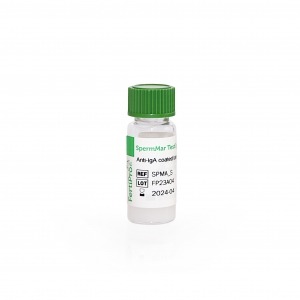Frequently asked questions: SpermMar IgA
FAQ1: What is the origin of the antibodies and other biological material?
The SpermMar Test IgA contains bovine sourced albumin. The beads are coated with rat anti-human IgA antibodies.
FAQ2: How long can we wait before the test should be performed?
Perform the test preferably within 1h after collection, especially in samples with low motility. If motility is high, it might be possible to perform the test later (max 3-4h later).
FAQ3: Can or should we do an indirect SpermMar IgA test ?
No, you probably shouldn’t.
Performance of the indirect IgA SpermMar test is to be considered experimental and the clinical meaning of its results has not been established.
FAQ4: Can we perform the SpermMar IgA test on washed spermcells ?
We advice against washing the spermcells before performing the direct SpermMar IgA test for a number of reasons.
First of all, some washing media contain human serum albumin (HSA). HSA tends to form a “shield” around the spermcells which hide the antibodies so that they can not be detected by the test method.
Secondly, washing the sperm sample will remove most of the antibodies that could be present in the seminal plasma and might thus render false negative results.
FAQ5: We do the SpermMar IgG test, should we also do the SpermMar IgA test ?
Some laboratories only do the SpermMar IgG on a routine basis, in case of a positive IgG they also do an IgA. It does happen however that a patient with a negative IgG is positive for IgA.
So, from a clinical point of view you should do both SpermMar IgG and SpermMar IgA, from an economical point of view however you would probably opt for the IgG as a routine test and IgA for positive IgG’s.
FAQ6: Why does the SpermMar IgG kit contain 2 bottles and the SpermMar IgA only 1 ?
The SpermMar IgG kit contains one bottle of latex particles coated with IgG and one bottle of anti-IgG antiserum. The antiserum actually links the antibodies on the surface of the spermatozoa to the antibodies on the surface of the latex particles.
The SpermMar IgA on the other hand contains only one bottle of latex particles coated with monoclonal anti-IgA directly linking the latex particles to the antibodies on the surface of the spermatozoa. The SpermMar IgA therefore only needs 1 bottle of reagents where the SpermMar IgG needs 2.
FAQ7: What is the difference between the single kit and the complete kit?
The single kit only contains the reagents, while the complete kit also contains the lab disposables (micro slides, cover glasses, microcapillary pipettes with rubber bulb).
FAQ8: Can the test be done on frozen/thawed semen samples?
No, it is recommended on native samples because HSA in cryoprotectant can mask anti-sperm antibodies on spermatozoa.
FAQ9: What is the shelf life after opening?
If the product is used aseptically, firmly closed and kept refrigerated between tests, the shelf life after opening remains the same as when unopened (12 months).
FAQ10: What are the minimal spermatozoa parameters needed to perform a SpermMar Test IgA?
A concentration of >10 million/ml and a progressive motility of >30 % is advisable. The sperm samples can be concentrated or diluted, but it is advisable not to use a medium containing HSA or another protein supplement as this can interfere with the test results.
FAQ11: Do you supply positive or negative controls for the SpermMar IgA test?
No, we don’t. The SpermMar Test IgA can only be performed on fresh, untreated spermatozoa. As motile spermatozoa are required to perform the test, it is impossible to prepare positive or negative controls for the SpermMar Test IgA.
FAQ12: When is it recommended to perform a quality control? How do we perform quality control on the SpermMar Test IgA, since no controls are available?
This decision is lab-dependent. Most labs do a quality control when starting a new lot.
Note that a complete QC check is performed before release (see COA per batch) by FertiPro. Following is tested:
– pH: 7.6-9.0
– Osmo: 310-370 mOsm/kg
– Concentration latex beads
– Functionality test on a negative and positive sample, in which we compare the batch with a previous released batch SpermMar IgA. Lots may not differ more than 10%.
Furthermore, internal quality control at the lab can be performed by using a new kit in comparison to an in-use kit and comparison of the results. Another option is, if positive and negative IgA sperm donors are known in the test lab, these can be used as negative and positive controls.

